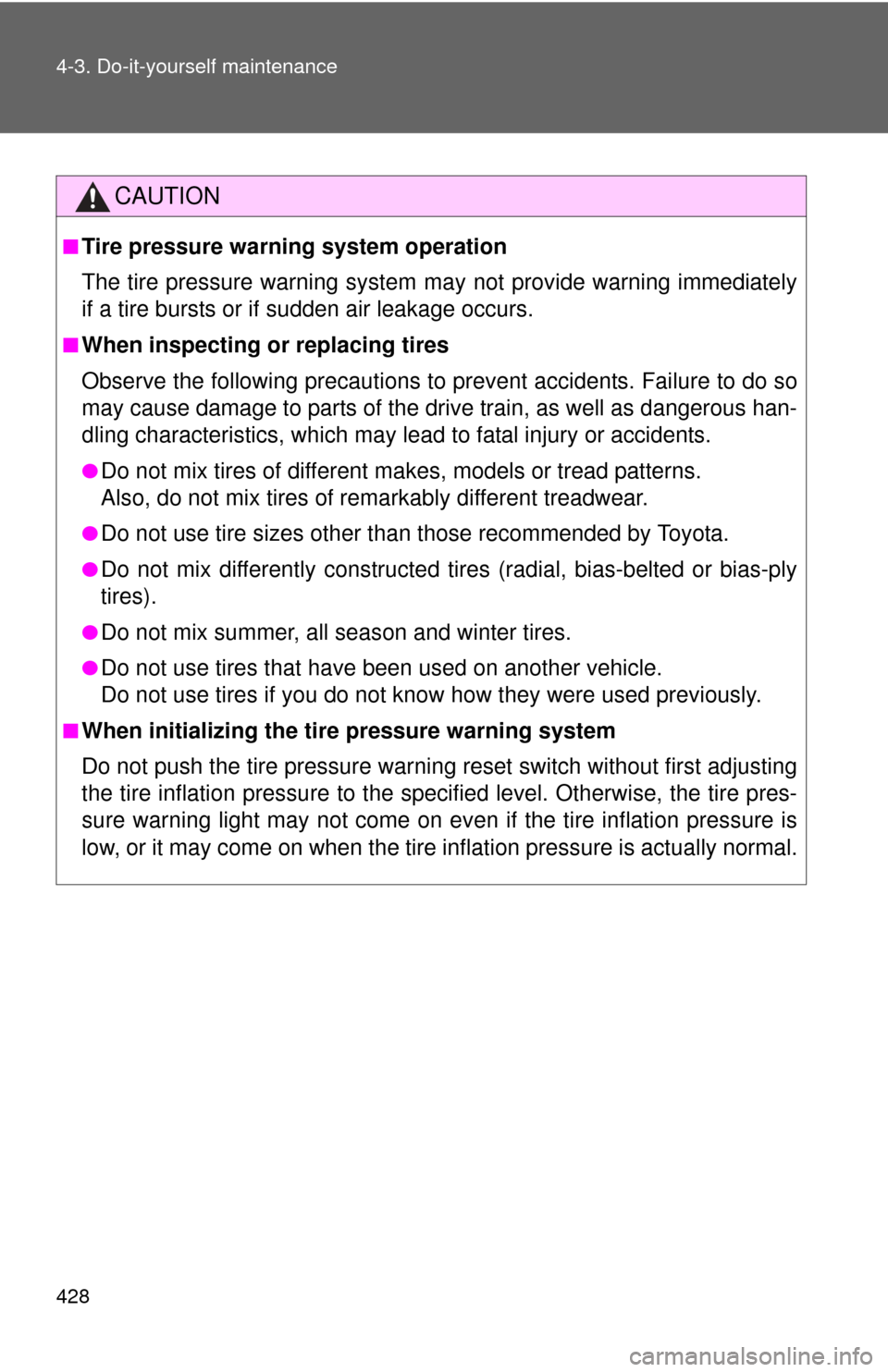Page 420 of 580
420 4-3. Do-it-yourself maintenance
Washer fluidIf any washer does not work or
the low washer fluid warning light
comes on, the washer tank may
be empty. Add washer fluid.
CAUTION
■When refilling the washer fluid
Do not refill the washer fluid when the engine is hot or running, as the
washer fluid contains alcohol and may catch fire if spilled on the engine etc.
NOTICE
■Do not use any fluid other than washer fluid
Do not use soapy water or engine antifreeze instead of washer fluid.
Doing so may cause streaking on the vehicle’s painted surfaces.
■ Diluting washer fluid
Dilute washer fluid with water as necessary.
Refer to the freezing temperatures listed on the label of washer fluid bottle.
Page 423 of 580

4
Maintenance and care
423
4-3. Do-it-yourself maintenance
■
How to initialize the tire pressure warning system
Park the vehicle in safe place and turn the “ENGINE START
STOP” switch or the engine switch OFF.
While the vehicle is moving, in itialization is not performed.
Adjust the tire inflation pressure to the specified cold tire infla-
tion pressure level. ( P. 526)
Make sure to adjust the tire pressure to the specified cold tire
inflation pressure level. The ti re pressure warning system will
operate based on this pressure level.
Turn the “ENGINE START STOP” switch to IGNITION ON
mode (vehicles with smart key sy stem) or the engine switch to
the “ON” position (vehicles without smart key system).
Push and hold the tire pressure
warning reset switch until the tire
pressure warning light blinks
slowly 3 times.
Vehicles with smart key system: Wait for a few minutes with
the “ENGINE START STOP” swit ch in IGNITION ON mode,
and then turn the “ENGINE START STOP” switch OFF.
Vehicles without smart key system: Wait for a few minutes
with the engine switch in the “O N” position, and then turn the
engine switch to the “LOCK” position.
STEP1
STEP2
STEP3
STEP4
STEP5
Page 424 of 580

424 4-3. Do-it-yourself maintenance
Registering ID codesThe tire pressure warning valve and transmitter is equipped with a
unique ID code.
When replacing a tire pressure warning valve and transmitter, it is
necessary to register the ID code of tire pressure warning valve and
transmitter. Have the ID code registered by your Toyota dealer.
■When to replace your vehicle’s tires
Tires should be replaced if:
●You have tire damage such as cuts, splits, cracks deep enough to
expose the fabric or bulges indicating internal damage
●A tire goes flat repeatedly or c annot be properly repaired due to the
size or location of a cut or other damage
If you are not sure, consult with your Toyota dealer.
■Replacing tires and wheels
If the ID code of the tire pressure warning valve and transmitter is not
registered, the tire pre ssure warning system will not work properly. After
driving for about 20 minutes, the tire pressure warning light blinks for 1
minute and stays on to indicate a system malfunction.
Page 427 of 580

4
Maintenance and care
427
4-3. Do-it-yourself maintenance
■When initialization of the tire
pressure warning system has failed
Initialization can be completed in a few minutes. However, in the follow-
ing cases, the settings have not b een recorded and the system will not
operate properly. If repeated attempts to record tire inflation pressure
settings are unsuccessful, have the vehicle inspected by your Toyota
dealer.
●When operating the tire pressure warning reset switch, the tire pres-
sure warning light doe s not blink 3 times.
●After carrying out the initialization procedure, the tire pressure warn-
ing light blinks for 1 minute then stays on after driving for about 20
minutes.
■Routine tire inflation pressure checks
The tire pressure warning system doe s not replace routine tire inflation
pressure checks. Make su re to check tire inflation pressure as part of
your routine of daily vehicle checks.
■Tire pressure warning system certification
FCC ID: PAXPMV107J
FCC ID: HYQ13BCX
For vehicles sold in the U.S.A.
This device complies with part 15 of the FCC Rules. Operation is subject
to the following two conditions: (1) This device may not cause harmful
interference, and (2) this device must accept any interference received,
including interference that may cause undesired operation.
FCC WARNING:
Changes or modifications not expre ssly approved by the party responsi-
ble for compliance could void the user’s authority to operate the equip-
ment.
For vehicles sold in Canada
Operation is subject to the following two conditions: (1) this device may
not cause interference, and (2) this de vice must accept any interference,
including interference that may caus e undesired operation of the device.
Page 428 of 580

428 4-3. Do-it-yourself maintenance
CAUTION
■Tire pressure warning system operation
The tire pressure warning system may not provide warning immediately
if a tire bursts or if sudden air leakage occurs.
■When inspecting or replacing tires
Observe the following precautions to prevent accidents. Failure to do so
may cause damage to parts of the drive train, as well as dangerous han-
dling characteristics, which may le ad to fatal injury or accidents.
●Do not mix tires of different makes, models or tread patterns.
Also, do not mix tires of remarkably different treadwear.
●Do not use tire sizes other than those recommended by Toyota.
●Do not mix differently constructed ti res (radial, bias-belted or bias-ply
tires).
●Do not mix summer, all season and winter tires.
●Do not use tires that have been used on another vehicle.
Do not use tires if you do not know how they were used previously.
■When initializing the tire pressure warning system
Do not push the tire pressure warnin g reset switch without first adjusting
the tire inflation pressure to the spec ified level. Otherwise, the tire pres-
sure warning light may not come on ev en if the tire inflation pressure is
low, or it may come on when the tire inflation pressure is actually normal.
Page 446 of 580
446 4-3. Do-it-yourself maintenance
Fuse layout and amperage ratings■ Engine compartment
FuseAmpereCircuit
1 RR DEF 50 A Rear window defogger, outside
rear view mirror defogger
2 ABS/VSC No.2 30 A Anti-lock brake system, vehicle
stability control system
3 RDI FAN 50 A Electric cooling fan
4 ABS/VSC No.1 50 A Anti-lock brake system, vehicle
stability control system
5 HEATER 50 A Air conditioning system
6 ST/AM2 30 A Starter system
7 MAIN 40 A Headlights
8ALT 140 A
or
120 A Charging system, RR DEF, ABS/
VSC No.2, HEATER, ABS/VSC
No.1, RDI FAN, WASHER,
S-HORN
Page 447 of 580
4
Maintenance and care
447
4-3. Do-it-yourself maintenance
FuseAmpereCircuit
9 STOP No.3 7.5 A Electronic controlled transmission
system, multiport fuel injection
system/sequential multiport fuel
injection system
10 INJ 15 A Multiport fuel injection system/
sequential multiport fuel injection
system
11 AM2 7.5 A Starter system
12 DOOR No.1 25 A Multiplex communication system
13 ALT-S 7.5 A Charging system
14 ETCS 10 A Multiport fuel injection system/
sequential multiport fuel injection
system
15 IG2 25 A Multiport fuel injection system/
sequential multiport fuel injection
system, electronic controlled
transmission system
16 TURN/HAZ 15 A Turn signal lights
17 AMP 30 A Audio system
18 EFI No.3 7.5 A Smart key system, electronic con-
trolled transmission system
19 STR LOCK 15 A Steering lock system
20 STOP No.1 15 A Multiplex communication system
Page 448 of 580
448 4-3. Do-it-yourself maintenance
FuseAmpereCircuit
21 EFI No.1 25 A Multiport fuel injection system/
sequential multiport fuel injection
system, fuel pump
22 HORN 10 A Horn
23 HEAD LH UPR 15 A Left-hand headlight (high beam)
24 HEAD RH UPR 15 A Right-hand headlight (high beam)
25 A/F 25 A Air fuel ratio sensor
26 WASHER 20 A Windshield washer
27 S-HORN 7.5 A Horn
28 DOME 7.5 A Gauges and meters, clock, front
personal lights, door courtesy
lights, garage door opener, rear
personal lights, trunk light
29 ECU-B 10 A Center display, multiplex
communication system
30 RAD No.1 15 A Audio system, center display,
navigation system
31 EFI No.2 10 A Multiport fuel injection system/
sequential multiport fuel injection
system
32 STOP No.2 7.5 A Stop lights, high mounted
stoplight, vehicle stability control
system, anti-lock brake system
33 HEAD RH LWR 15 A Right-hand headlight (low beam)
34 HEAD LH LWR 15 A Left-hand headlight (low beam)